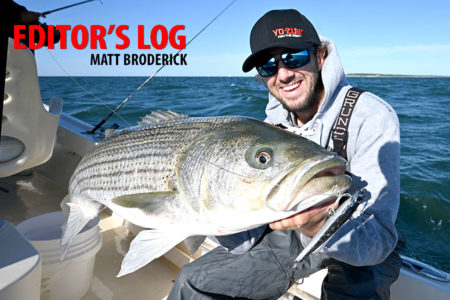In his April edition editorial, New England managing editor Dave Anderson waded into the topic of industrial offshore wind (Editor’s Log: Is This Really A Victory?) in a rather profound way. “Offshore wind sounds like a good idea, it does! But it has been spun to ‘sell’ it to the public,” Dave wrote, going to include the following passage:
“I was in full support of it before I started researching it. If you don’t believe that we’ve been lied to, just take into account the fact that – early on – we were ‘sold’ the idea that since the turbines would be situated more than 10 miles offshore and the human eye can only see 3 miles to horizon that we wouldn’t be able to see them…the important fact that was omitted (or perhaps strategically [redacted]) is that the turbines are over 900 feet tall and would not be subject to horizon obstruction. In fact, even if the turbines were 30 miles offshore, the horizon obstruction is still only about 480 feet above sea level, leaving roughly half of the average turbine visible on a clear day.”
Dave uncovered another golden nugget of half-truth in the industrial offshore wind debate, the movement of turbines farther from shore to placate the “naked eye” critics. According to the Bureau of Ocean Energy Management (BOEM), in their words, “When a wind farm is located further than 30 miles from shore, additional equipment is required to effectively move this energy onshore without encountering significant losses of power during transmission.”
BOEM describes in detail how a high voltage direct current (HVDC) system is used to convert alternating current (AC) generated from wind turbines to direct current (DC) for transporting longer distances. “The conversion process from AC to HVDC generates heat as a byproduct, and the systems require cooling to protect the equipment from damage and breakdown,” BOEM explains in their technical documentation.
“These facilities will use sea water to cool their mechanisms,” Dave noted in his editorial, outlining how each substation will pump an average of 10 million gallons of sea water per day, treated with various chemicals including sodium hypochlorite, heated to temperatures as high as 90 degrees before discharging that warmwater coolant back into our oceans. “Using Mayflower Wind as an example, they’re proposing 147 turbines with five substations or, roughly one substation per 30 turbines,” Dave said, going on to add “If we extrapolate that out to the roughly 1000 turbines currently planned throughout New England waters, that’s 33 substations and more than 333 million gallons of heated and heavily chlorinated water pumped into the Atlantic, daily.”
I saw another half-truth recently shared at the Kool-Aid line where the industrial offshore wind support checks are distributed, and that’s how wind turbine clusters off our coast will act as “fish factories.” While it’s conceivable that black sea bass could amass around the hundreds and thousands of monopiles driven into the ocean floor, these monstrosities are not factories that produce more fish, even if they could act as aggregators, making black sea bass, for example, easier to catch. But think about what you know of the basics of fisheries management; when does catching more fish ever lead to better regulations?
Fisheries managers estimate that the current spawning stock biomass of black sea bass is 2.1 times the original management target, yet whenever we catch more sea bass in one year based on existing season, size and bag restrictions, we typically get hit by harvest reductions soon after. If it gets easier to catch more black sea bass in quicker fashion, NOAA has already acknowledged that will likely lead to increased precaution and lower quotas; that’s basic fisheries management 101!
Dave asks, “Is this really a victory?” Well, my friend, perhaps a Pyrrhic victory, one which one brings such significant harm to our coastal communities that it differs little from defeat.



